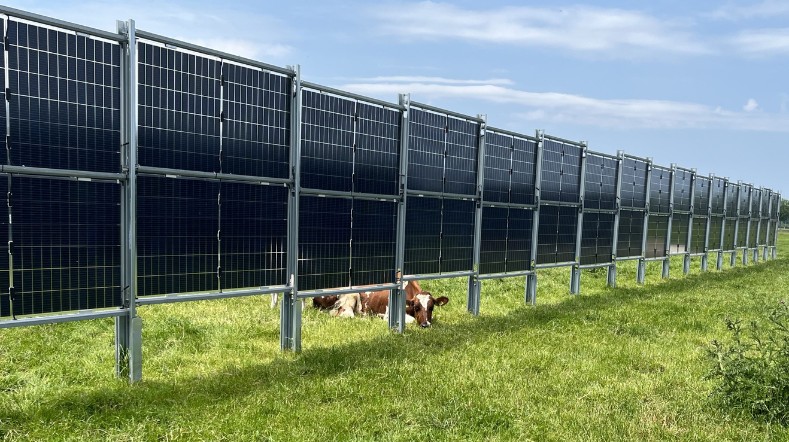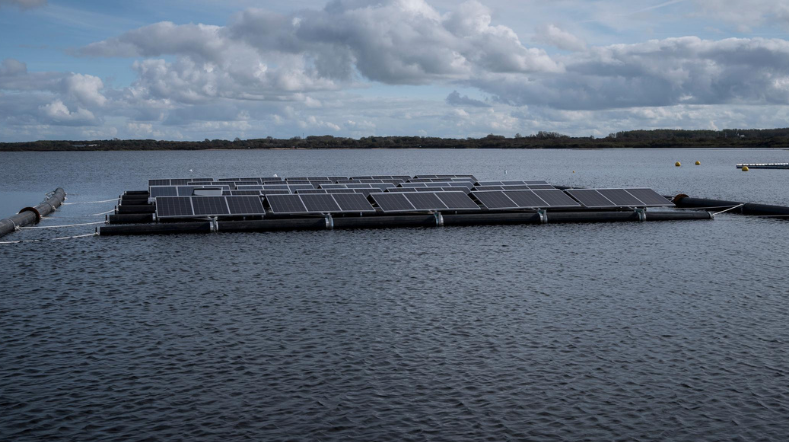
Floating solar panels
Floating solar will make a significant contribution to the energy transition. Some scenarios predict 200 gigawatt peak (GWp) of solar power in the Netherlands in 2050, 25 GWp of which will be on inland waters and 45 GWp at sea. The knowledge level is still insufficient. For example, on the effect of wind and waves on solar panels and the lifetime of floating solar energy systems. Therefore, we are conducting plenty of research that fits with our mission to make solar energy applicable to different types of surface.
Discover TNO's methods for monitoring offshore solar projects in the North Sea to ensure reliability and performance.
Wave Category 2
In 2017, together with partners from the National Consortium Solar on Water, we conducted a study on the feasibility of solar energy systems on water surfaces with wave category 2, waves until 1 meter high. This research took place at the Slufter on the Maasvlakte. The project provided a comprehensive inventory of challenges and potential failure mechanisms in these types of systems.
Performance of panels and ecological effects
The field lab located on the shores of the Oostvoornse Meer offers space for a variety of research projects on floating solar energy systems. At the field lab, floating solar energy systems are subjected to challenging conditions, such as wave category 2 and corrosive conditions. We are also researching the ecological impact of these systems on marine life and water quality.
An interesting line of thought is the construction of ring-shaped islands in the IJsselmeer, so-called atolls. This would allow us to create a lee area suitable for floating solar energy systems that can withstand wave category-2 conditions. This approach can go hand in hand with the required nature development (Natura 2000).
A next step is to use the surface of the IJsselmeer for solar energy. The IJsselmeer also has quite a substantial task in terms of nature development. The question is whether the development of new nature in the IJsselmeer region and solar energy can go hand in hand. Do we see opportunities for synergy on a spatial planning, policy, and/or financial level?
Offshore floating solar panels
In the North Sea, a large area has been earmarked for offshore renewable energy. Initially for wind energy, but there is enough space in between the wind turbines to generate solar energy as well. We are collaborating on several projects focused on how to achieve robust offshore floating solar energy systems with high yields and long service lives at acceptable costs.
TNO develops standards for monitoring offshore solar energy pilot projects
Offshore solar energy on the North Sea is increasingly gaining attention. Several pilots and demonstration projects are now in development. It is of key importance that we use these pilots and demonstration projects in The Netherlands to build our knowledge about offshore solar. TNO is closely involved with:
- Demonstration project at the CrossWind HKN location, with Oceans of Energy
- Merganser demonstration project at the OTS site, with SolarDuck
- Solar@Sea III pilot project at the OTS site with Bluewater Energy Services
In order to build up high quality systematic knowledge about performance and reliability, TNO strives to use the same monitoring approach in all these projects. It is important to monitor the following aspects of the systems:
- Mechanical behaviour of the system and the mechanical stresses and strains experienced by the components such as the PV panels
- Electrical performance of the PV system, its power yield as a functional result of irradiation, temperatures and system movements
- Visual parameters such as fouling
TNO aims to gather these data in a standardized way, using offshore compatible measurement methodologies and sensors. Analysis of such data will lead to a better understanding of the systematic performance aspects that are independent of the precise design choices for the systems.
Carbon footprint floating solar energy systems
TNO analysed the carbon footprint of floating solar systems. The outcome can be read in the report written for IEA (International Energy Agency) PVPS Task 12.
Projects offshore floating solar
We contribute to these projects from various areas of expertise and labs. Examples include solar energy components (modules and electronics) and complete systems, as well as new measurement methods to examine systems and components.
The first floating pontoons from the Oceans of Energy company have now endured storms and high waves at a test site off the coast of Zeeland. A first step in demonstrating that offshore solar farms continue to function under severe weather conditions.
Oceans of Energy will build 1 megawatt (mWp) of offshore solar in the NS2 project, 12 km off the coast of Scheveningen. Partners are TNO, Deltares, NIOZ, WMR, TKF and Primo Marine. We'll be researching the suitability of solar panels for offshore use, and are investigating integration at wind farms.
Within the Solar@Sea project, Bluewater, Endures, Genap, Marin, TNO and Avans Hogeschool are working together at a concept based on a flexible structure. The basic idea here is to make the structure move optimally with the waves and to apply flexible solar panels. In this way, the consortium hopes to arrive at a robust solution that can withstand the forces of nature and achieves a high yield.
The CrossWind consortium, a joint venture of Shell in the Netherlands and Eneco, is building the new offshore wind farm Hollandse Kust (Noord). Together with CrossWind, we are working on research and a demonstration of solar energy at sea at this new offshore wind farm. The Hollandse Kust (Noord) offshore wind farm is expected to be operational in 2023. The offshore solar demonstration at this site will be 500 kWp in size and is planned for 2025.
In the Merganser project, we are collaborating with SolarDuck, Marin, Deltares and TU Delft. The consortium will develop, test and validate an offshore solar pilot installation under offshore (North Sea) weather conditions. The installation consists of 6 coupled platforms with a total capacity of 500 kWp. Through this project, the consortium aims to gain more insight into the suitability of the technology to operate under extreme offshore conditions. In addition, the partners are researching the ecological impact of such solar energy systems at sea and the incorporation of solar energy into offshore wind farms.

Get inspired
Carbon footprint floating solar energy systems similar to land systems


SWITCH tackles the energy issues of the future


SWITCH field lab of TNO and Wageningen University & Research/ACRRES opened


Study solar systems in dairy farming launched


TNO's view of 2030: using every surface for solar power generation



